 September marks a milestone in the history of recorded classical music: 25 years since the establishment of the Naxos label. Originally regarded with disdain by the record business establishment, this “budget” line of CDs has gone on to become the largest manufacturer and distributor of classical CDs and digital downloads in the world. Later this month Naxos founder Klaus Heymann will be in Toronto for a media event celebrating the anniversary and the release of The Story of Naxos — The extraordinary story of the independent record label that changed classical recording for ever.
September marks a milestone in the history of recorded classical music: 25 years since the establishment of the Naxos label. Originally regarded with disdain by the record business establishment, this “budget” line of CDs has gone on to become the largest manufacturer and distributor of classical CDs and digital downloads in the world. Later this month Naxos founder Klaus Heymann will be in Toronto for a media event celebrating the anniversary and the release of The Story of Naxos — The extraordinary story of the independent record label that changed classical recording for ever.
In the two months since the last issue we have received 21 CDs on the Naxos label and more than 80 on labels distributed by Naxos. And that is just the number that has physically crossed my desk; there were more than 200 separate titles listed on the August release sheets alone. For this month’s column I decided I would select a few of the discs that were of most interest to me personally from this wealth of material. This proved harder than I first imagined. Since my own area of expertise is music of the 20th century I decided to limit myself to this field and even so I ended up bringing ten discs home; a selection of works with which I was already familiar and a number which were new to my ears. Space precludes any in-depth analysis of the recordings, but suffice it to say that with minor hesitations as noted, none of the discs disappointed me and a number of them were very satisfying indeed.
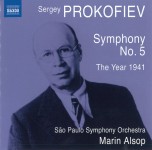 Although well versed in the chamber music and concertos of Sergei Prokofiev, I am less familiar with his other orchestral and particularly symphonic output (with the exception of the ever-popular “Classical” Symphony). I chose a recording of two works composed during the Second World War, the symphonic suite The Year 1941 and the Symphony No.5 in B-Flat Major, Op.100 performed by the São Paulo Symphony Orchestra under Marin Alsop (8.573029). The first of these works is, perhaps understandably, bombastic with its patriotic movements “In the Struggle,” “In the Night”and “For the Brotherhood of Man,” but nevertheless well crafted and well performed. The symphony is more abstract in nature and although still noticeably nationalistic is not overtly jingoistic.
Although well versed in the chamber music and concertos of Sergei Prokofiev, I am less familiar with his other orchestral and particularly symphonic output (with the exception of the ever-popular “Classical” Symphony). I chose a recording of two works composed during the Second World War, the symphonic suite The Year 1941 and the Symphony No.5 in B-Flat Major, Op.100 performed by the São Paulo Symphony Orchestra under Marin Alsop (8.573029). The first of these works is, perhaps understandably, bombastic with its patriotic movements “In the Struggle,” “In the Night”and “For the Brotherhood of Man,” but nevertheless well crafted and well performed. The symphony is more abstract in nature and although still noticeably nationalistic is not overtly jingoistic.
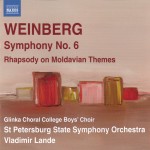 The next up on my unknown list was the Symphony No.6, Op.79 and the Rhapsody on Moldavian Themes,works dating from 1963 and 1949 respectively, by another Soviet composer, Mieczyslaw Weinberg (8.572779), performed by the St. Petersburg State Symphony Orchestra under Vladimir Lande. Weinberg fled to Russia to escape the Nazi invasion of Poland and his music is receiving quite a bit of attention and a plethora of recordings in recent years. I first became aware of his music about five years ago on a CD featuring the ARC (Artists of the Royal Conservatory) ensemble, here in Toronto. Weinberg was a protégé of Shostakovich and his music is often reminiscent of that master’s work.
The next up on my unknown list was the Symphony No.6, Op.79 and the Rhapsody on Moldavian Themes,works dating from 1963 and 1949 respectively, by another Soviet composer, Mieczyslaw Weinberg (8.572779), performed by the St. Petersburg State Symphony Orchestra under Vladimir Lande. Weinberg fled to Russia to escape the Nazi invasion of Poland and his music is receiving quite a bit of attention and a plethora of recordings in recent years. I first became aware of his music about five years ago on a CD featuring the ARC (Artists of the Royal Conservatory) ensemble, here in Toronto. Weinberg was a protégé of Shostakovich and his music is often reminiscent of that master’s work.
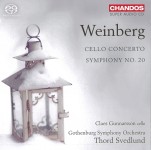 While I enjoyed the Naxos CD I found the Weinberg Cello Concerto, Op.43 contained on a recent Chandos release (CHSA 5107) of more interest, likely to do with my own kinship with that low member of the violin family. Although composed in 1948, the concerto had to wait until 1957 for its first performance. Rostropovich gave that premiere and the work is eminently suited to the big sound of that late maestro. Claes Bunnarsson proves himself well equal to the task in this performance with the Gothenburg Symphony Orchestra under Thord Svedlund. The disc also includes the premiere recording (and perhaps first performance according to the detailed liner notes) of Weinberg’s Symphony No.20, Op.150 dating from 1988 (eight years before his death). I mention this recording here as Chandos is one of the many major labels now distributed by Naxos. I’m tempted to note that this is the first recording I’ve seen that includes a logo reflecting sponsorship from Volvo.
While I enjoyed the Naxos CD I found the Weinberg Cello Concerto, Op.43 contained on a recent Chandos release (CHSA 5107) of more interest, likely to do with my own kinship with that low member of the violin family. Although composed in 1948, the concerto had to wait until 1957 for its first performance. Rostropovich gave that premiere and the work is eminently suited to the big sound of that late maestro. Claes Bunnarsson proves himself well equal to the task in this performance with the Gothenburg Symphony Orchestra under Thord Svedlund. The disc also includes the premiere recording (and perhaps first performance according to the detailed liner notes) of Weinberg’s Symphony No.20, Op.150 dating from 1988 (eight years before his death). I mention this recording here as Chandos is one of the many major labels now distributed by Naxos. I’m tempted to note that this is the first recording I’ve seen that includes a logo reflecting sponsorship from Volvo.
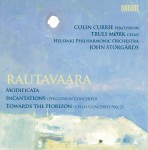 A second disc I was drawn to because of the prominence of the cello is on another label from Naxos’ distribution stable. Truls Mørk is the soloist in Einojuhani Rautavaara’s Towards the Horizon (Cello Concerto No.2) on a recent Ondine release (ODE 11782) which also includes the percussion concerto Incantations featuring Colin Currie, both dating from 2008, and the 1957 orchestral composition Modificata which was revised in 2003. All are performed with the Helsinki Philharmonic Orchestra under John Storgärds direction. My proclivity for the cello notwithstanding, it was the percussion concerto with its (mostly) subdued use of mallet instruments which I found most satisfying.
A second disc I was drawn to because of the prominence of the cello is on another label from Naxos’ distribution stable. Truls Mørk is the soloist in Einojuhani Rautavaara’s Towards the Horizon (Cello Concerto No.2) on a recent Ondine release (ODE 11782) which also includes the percussion concerto Incantations featuring Colin Currie, both dating from 2008, and the 1957 orchestral composition Modificata which was revised in 2003. All are performed with the Helsinki Philharmonic Orchestra under John Storgärds direction. My proclivity for the cello notwithstanding, it was the percussion concerto with its (mostly) subdued use of mallet instruments which I found most satisfying.
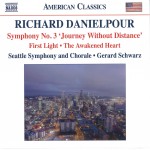 One of Naxos’ most prolific lines is the American Classics series. Richard Danielpour, a composer whose work I first came across in a recording of a cello concerto written for Yo-Yo Ma, is featured on a recent release with the Seattle Symphony and Chorale under Gerard Schwarz (8.559712). What drew me to the disc was the Symphony No.3 “Journey Without Distance” when I first conceived of this column, thinking it would focus on modern symphonies. While the symphony is a striking work featuring soprano Faith Esham as the “voice of as angel” in a transcendent text by Helen Schucman, it was The Awakened Heart, a purely instrumental work (in spite of literary references in the movement titles) which captured my attention. It dates from 1990 and is a dramatic and often exuberant work, at times reminiscent of the hybrid of symphonic and theatrical music in Leonard Bernstein’s oeuvre.
One of Naxos’ most prolific lines is the American Classics series. Richard Danielpour, a composer whose work I first came across in a recording of a cello concerto written for Yo-Yo Ma, is featured on a recent release with the Seattle Symphony and Chorale under Gerard Schwarz (8.559712). What drew me to the disc was the Symphony No.3 “Journey Without Distance” when I first conceived of this column, thinking it would focus on modern symphonies. While the symphony is a striking work featuring soprano Faith Esham as the “voice of as angel” in a transcendent text by Helen Schucman, it was The Awakened Heart, a purely instrumental work (in spite of literary references in the movement titles) which captured my attention. It dates from 1990 and is a dramatic and often exuberant work, at times reminiscent of the hybrid of symphonic and theatrical music in Leonard Bernstein’s oeuvre.
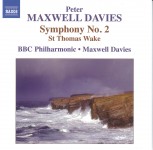
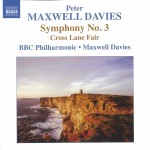 I was not previously familiar with the symphonic output of British composer Peter Maxwell Davies although certainly aware of his cycle of string quartets (commissioned by Naxos) and such modern classics as Eight Songs for a Mad King and Orkney Wedding, with Sunrise. I was a little surprised to learn that he has written nine symphonies and if recent releases are an indication I assume we will see all of them from Naxos in the coming months. I added Symphony No.2 (1980) (8.572349) and Symphony No.3 (1984) (8.572350), both performed by the BBC Philharmonic under the composer’s direction,to my carry home bag and have enjoyed both of these textural pieces. I would almost consider them concertos for orchestra rather than symphonies, not because of sectional virtuosity but because they seem to be more about the different sonic possibilities inherent in the ensemble than in thematic development. The caveats I mentioned earlier in this article have to do specifically with these two discs. Each of the symphonies is accompanied by what I would call an incidental piece. Although the premise of each — St. Thomas Wake (Foxtrot for orchestra on a pavan by John Bull) and Cross Lane Fair — is “serious” enough, with separate dance band and Northumbrian pipes and bodhran respectively, they come across as merely pastiche. This is not to suggest that they are not a worthy part of Maxwell Davies’ oeuvre, simply that I would prefer a so-called “separation of church and state” — discs of symphonic repertoire on the one hand and of the more theatrical music on another.
I was not previously familiar with the symphonic output of British composer Peter Maxwell Davies although certainly aware of his cycle of string quartets (commissioned by Naxos) and such modern classics as Eight Songs for a Mad King and Orkney Wedding, with Sunrise. I was a little surprised to learn that he has written nine symphonies and if recent releases are an indication I assume we will see all of them from Naxos in the coming months. I added Symphony No.2 (1980) (8.572349) and Symphony No.3 (1984) (8.572350), both performed by the BBC Philharmonic under the composer’s direction,to my carry home bag and have enjoyed both of these textural pieces. I would almost consider them concertos for orchestra rather than symphonies, not because of sectional virtuosity but because they seem to be more about the different sonic possibilities inherent in the ensemble than in thematic development. The caveats I mentioned earlier in this article have to do specifically with these two discs. Each of the symphonies is accompanied by what I would call an incidental piece. Although the premise of each — St. Thomas Wake (Foxtrot for orchestra on a pavan by John Bull) and Cross Lane Fair — is “serious” enough, with separate dance band and Northumbrian pipes and bodhran respectively, they come across as merely pastiche. This is not to suggest that they are not a worthy part of Maxwell Davies’ oeuvre, simply that I would prefer a so-called “separation of church and state” — discs of symphonic repertoire on the one hand and of the more theatrical music on another.
With my space rapidly running out I will just briefly mention my “old favourites” revisited in recent Naxos recordings.
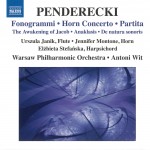 The abrasive music of then young Polish composer Krzysztof Penderecki was an important aspect of my introduction to the music of the 20th century. There have been a number of recent Naxos Penderecki releases, each of which combines his youthful output with more conservative works of his mature years. Fonogrammi/Horn Concerto/Partita (8.572482) includes Fonogrammi for flute and chamber orchestra, Anaklasis for string orchestra and percussion and De natura sonoris I for orchestra, all from the 1960s, with several works from the 70s and the much more recent Horn Concerto “Winterreise”(2009).With a variety of soloists the Warsaw Philharmonic Orchestra and Anthony Wit provide definitive performances.
The abrasive music of then young Polish composer Krzysztof Penderecki was an important aspect of my introduction to the music of the 20th century. There have been a number of recent Naxos Penderecki releases, each of which combines his youthful output with more conservative works of his mature years. Fonogrammi/Horn Concerto/Partita (8.572482) includes Fonogrammi for flute and chamber orchestra, Anaklasis for string orchestra and percussion and De natura sonoris I for orchestra, all from the 1960s, with several works from the 70s and the much more recent Horn Concerto “Winterreise”(2009).With a variety of soloists the Warsaw Philharmonic Orchestra and Anthony Wit provide definitive performances.
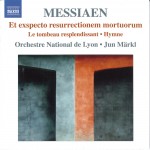 Olivier Messiaen’s Et exspecto resurrectionem mortuorum (8.572714) is a devotional work from 1964. The Orchestre National de Lyon gives a strong performance under the direction of Jun Märki, but without ecstatic interludes such as those included in the earlier Turangalîla Symphony, to my ears the piece is a little “too much of a muchness.” The disc is redeemed however by the inclusion of two early orchestral works which provide welcome dramatic contrast: Le Tombeau resplendissant (1931) and Hymne (1932).
Olivier Messiaen’s Et exspecto resurrectionem mortuorum (8.572714) is a devotional work from 1964. The Orchestre National de Lyon gives a strong performance under the direction of Jun Märki, but without ecstatic interludes such as those included in the earlier Turangalîla Symphony, to my ears the piece is a little “too much of a muchness.” The disc is redeemed however by the inclusion of two early orchestral works which provide welcome dramatic contrast: Le Tombeau resplendissant (1931) and Hymne (1932).
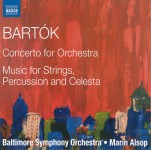 Saving the best for last, Marin Alsop returns with a recording of Bartók’s Concerto for Orchestra (1943) and Music for Strings, Percussion and Celesta (1936) (8.572486). In this instance she is conducting the Baltimore Symphony Orchestra in performances that rival any I’ve heard of these two works which number among my very favourites.
Saving the best for last, Marin Alsop returns with a recording of Bartók’s Concerto for Orchestra (1943) and Music for Strings, Percussion and Celesta (1936) (8.572486). In this instance she is conducting the Baltimore Symphony Orchestra in performances that rival any I’ve heard of these two works which number among my very favourites.
Naxos is to be commended for its commitment to thoroughness, excellence and affordability. This small sampling of recent output only includes the art music of our time. It must be pointed out that the Naxos catalogue is just as extensive, one could say exhaustive, in classical repertoire from the Renaissance through the Baroque, Classical and Romantic eras. And as Nicholas Soames, author of The Story of Naxos and director of Naxos AudioBooks would certainly point out, the Naxos catalogue extends far beyond the scope of classical music. There are two things I look forward to in the coming month: finding the time to read Soames’ story of this innovative company that has changed the history of recorded music in our time, and the newest addition to the Naxos Canadian Classics series, Dreamscapes, featuring orchestral music by Vivian Fung due out on September 23.
Of related interest: Jerry Fink, former CEO and President of Naxos of Canada Ltd., will present a ten-week class surveying the history of Western “classical” music from a Jewish viewpoint. Jewish involvement in the development of “classical” music from before the Byzantine Empire to the present day will be explored historically and examined musically. Examples from the presentation include: the Psalms and their use in Christian church music; Jewish troubadours of the Middle Ages; a Jewish national music school in pre-Soviet Russia. Thursday evenings beginning October 4 at Holy Blossom Temple. Tuition fee $235 (416-789-7400).
We welcome your feedback and invite submissions. CDs and comments should be sent to: The WholeNote, 503–720 Bathurst St., Toronto ON M5S 2R4. We also encourage you to visit our website, thewholenote.com, where you can find added features including direct links to performers, composers and record labels, and additional, expanded and archival reviews.
— David Olds, DISCoveries Editor, discoveries@thewholenote.com



